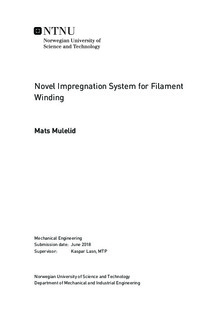Novel Impregnation System for Filament Winding
Master thesis
Permanent lenke
http://hdl.handle.net/11250/2562315Utgivelsesdato
2018Metadata
Vis full innførselSamlinger
Sammendrag
A new enclosed impregnation system for the filament winding machine at NTNU has been designed and manufactured. The impregnation system concist of three main parts, the impregnation unit, resin reservoir and fixtures. The impregnation unit has three main parts, two aluminum parts that greates a sinusoidal shape, and a disposable PTFE tube. The fibers are only in contact with the PTFE tube and the resin. Winding with the new system was easy and did not lead to any issues. The composite quality was evaluated by mechanical testing and microscopy. Two types of composite tubes were wound with the system and with the resin bath system as a reference. The tubes were wound with 4 and 24 layers. The 4 layer tubes were tested in split-disk tensile tests. Results from the split-disk tensile test show that the apparent tensile strength of composite material, with an average of 1860.9 MPa, from the new impregnation system is comparable to the reference material, 1754.5 MPa. The 24 layer tubes were tested in short-beam shear conditions. The composite made with the new impregnation system had an average short-beam strength of 37.5 MPa, and the reference strength was 36.5 MPa. Taken into account the standard deviation of the tests there are grounds for stating that the new impregnation system makes composite material with short-term mechanical properties equal to the reference system.
Microscopy and image analysis was conducted on material made by the new system and the reference system. The image analysis software CellProfiler was used to make programs to identify fiber volume fraction and void content of the composites. Image analysis show that the 4 layer tube made with the new system has a lower fiber volume fraction than the reference tube, and lower void content. This indicates that the composite made with the new system has a high resin volume fraction. Analysis of the 24 layer tubes and 4 layer tubes made at different winding speeds indicate that the new impregnation system is capable of manufacturing composites with an average fiber volume fraction of 60.4 \%.
The conclusion of the project is that the new impregnation system makes composite materials with short-term mechanical properties comparable to the reference system. The project did not identify anything that should discourage further developement of the impregnation system.
